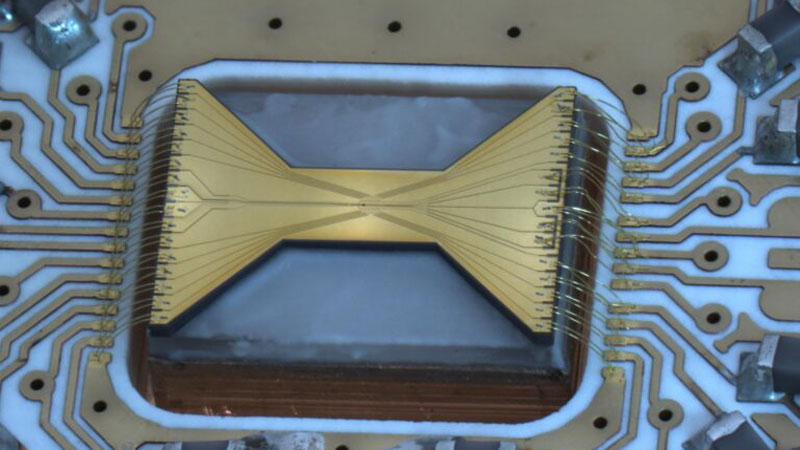Quantum teleportation was first used for distributed quantum calculations


Like classic computers, quantum computers will sooner or later require cluster configurations or distributed calculations. Practice shows that in this way it is easier to increase computing resources than to locally scale one system. You can implement the transmission of quantum data through a classic channel, but this usually leads to an increase in errors. It would be much more reliable to teleport the conditions, the benefit of quantum physics allows this.


A typical quantum processor on ion traps. Image source: NIST
We will immediately clarify that the quantum teleportation does not transmit energy and information. With its help, a quantum state is transmitted, for example, the direction of the back of an electron or atom (ion). Since before measuring the back (or other quantum states of the object) at the transmitting end can not be known in advance, for the receiving side the transmission will not carry semantic filling. However, if the teleportation is included in the computing process, then some (meaningless in all other conditions) the intermediate state obtained on one platform can be teleported to continue calculations on the remote platform.
Previously, a quantum teleportation when performing calculations was implemented within the framework of one “chip”. Scientists from Oxford University (Oxford University) scored two spaced quantum platforms on cubes from ions to check the possibility of distributed calculations using the effect of quantum teleportation. “Computers” were from each other at a distance of two meters, but could be located in different rooms or even further. In the end, this is only a matter of the cost of laboratory equipment.
Calcated ions of calcium and strontium were used as cubes – each pair in its trap that plays the role of a computer. In such a cluster, calcium ions served as local memory, and Ion Strontia worked as a transmitter and, at the other end, as a quantum state receiver. Both John Strontius confused photons through an optical cable, after which the entire system began to work as a whole.
Prior to the establishment of a confusing state, the system remained in the initial state. But as soon as the confusion occurred, Ion Strontia emitted the photon, which signaled the readiness of the system for calculations. The presented installation made it possible to implement the simplest logical operation Czgate (controlled Z). This is one of the basic quantum valves (gates), so the algorithm for cluster calculations in principle can be anything.
The experiments showed that the accuracy of calculations during teleportation of an intermediate result from the cubit to the cube was 70 %, but only due to the use of inexpensive equipment for the traps of ions. From the point of view of teleportation alone, accuracy reached 97 %. This is significantly lower than the accuracy of many modern quantum platforms, but there is already a certain result with which you can continue work.
With the correct combination of teleportation operations, it is possible to recreate a complete set of logical quantum elements. In other words, you can create a universal quantum computer capable of performing any quantum algorithm, simply using teleportation. Thus, the term “gates of teleportation” can confidently migrate from science fiction to our lives, albeit not as dreamed.
Recent Posts
MSI MPG Infinite X3 AI 2nd System Unit Review: All That’s Left to Do Is Play
As part of the expansion of the diversity of the "Laptops and PCs" section, it's…
Curator Deflects Largest DDoS Botnet in History with 4.6 Million Devices
Curator (formerly Qrator Labs) reported successfully neutralizing the largest DDoS botnet ever observed, consisting of…
Gigabyte Introduces AORUS Z890 Tachyon ICE Motherboard Without Conventional DIMM Slots — Only CAMM2
Gigabyte has unveiled the AORUS Z890 Tachyon ICE motherboard at Computex 2025, which features CAMM2…
Trump tariffs will break the internet, analysts fear
The trade war started by Donald Trump, involving almost all countries in the world, threatens…
Google has started filling its AI Mode search with unstoppable ads
Google has begun testing ads in its new AI-powered search feature, AI Mode. Now, when…
SnowRunner creators’ ‘revolutionary’ RoadCraft simulator earns ‘mixed’ reviews on Steam release
As promised, the “revolutionary” construction simulator RoadCraft from Saber Interactive (SnowRunner, Expeditions: A MudRunner Game)…